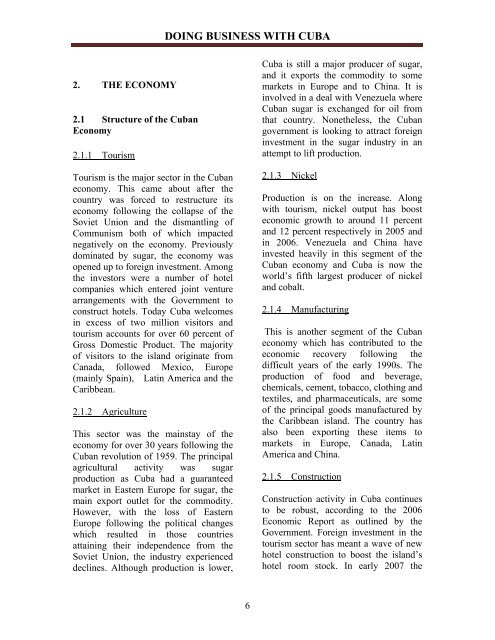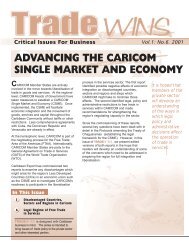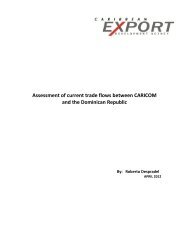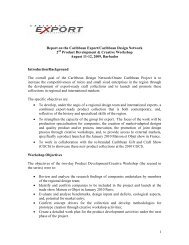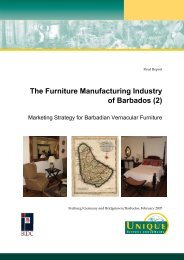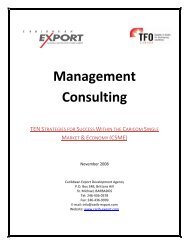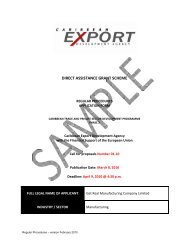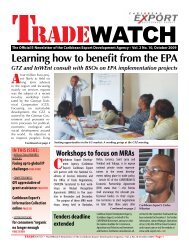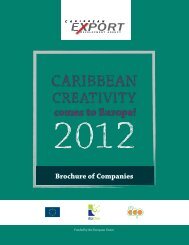doing business with cuba - Caribbean Export Development Agency
doing business with cuba - Caribbean Export Development Agency
doing business with cuba - Caribbean Export Development Agency
You also want an ePaper? Increase the reach of your titles
YUMPU automatically turns print PDFs into web optimized ePapers that Google loves.
2. THE ECONOMY<br />
2.1 Structure of the Cuban<br />
Economy<br />
2.1.1 Tourism<br />
Tourism is the major sector in the Cuban<br />
economy. This came about after the<br />
country was forced to restructure its<br />
economy following the collapse of the<br />
Soviet Union and the dismantling of<br />
Communism both of which impacted<br />
negatively on the economy. Previously<br />
dominated by sugar, the economy was<br />
opened up to foreign investment. Among<br />
the investors were a number of hotel<br />
companies which entered joint venture<br />
arrangements <strong>with</strong> the Government to<br />
construct hotels. Today Cuba welcomes<br />
in excess of two million visitors and<br />
tourism accounts for over 60 percent of<br />
Gross Domestic Product. The majority<br />
of visitors to the island originate from<br />
Canada, followed Mexico, Europe<br />
(mainly Spain), Latin America and the<br />
<strong>Caribbean</strong>.<br />
2.1.2 Agriculture<br />
This sector was the mainstay of the<br />
economy for over 30 years following the<br />
Cuban revolution of 1959. The principal<br />
agricultural activity was sugar<br />
production as Cuba had a guaranteed<br />
market in Eastern Europe for sugar, the<br />
main export outlet for the commodity.<br />
However, <strong>with</strong> the loss of Eastern<br />
Europe following the political changes<br />
which resulted in those countries<br />
attaining their independence from the<br />
Soviet Union, the industry experienced<br />
declines. Although production is lower,<br />
DOING BUSINESS WITH CUBA<br />
6<br />
Cuba is still a major producer of sugar,<br />
and it exports the commodity to some<br />
markets in Europe and to China. It is<br />
involved in a deal <strong>with</strong> Venezuela where<br />
Cuban sugar is exchanged for oil from<br />
that country. Nonetheless, the Cuban<br />
government is looking to attract foreign<br />
investment in the sugar industry in an<br />
attempt to lift production.<br />
2.1.3 Nickel<br />
Production is on the increase. Along<br />
<strong>with</strong> tourism, nickel output has boost<br />
economic growth to around 11 percent<br />
and 12 percent respectively in 2005 and<br />
in 2006. Venezuela and China have<br />
invested heavily in this segment of the<br />
Cuban economy and Cuba is now the<br />
world’s fifth largest producer of nickel<br />
and cobalt.<br />
2.1.4 Manufacturing<br />
This is another segment of the Cuban<br />
economy which has contributed to the<br />
economic recovery following the<br />
difficult years of the early 1990s. The<br />
production of food and beverage,<br />
chemicals, cement, tobacco, clothing and<br />
textiles, and pharmaceuticals, are some<br />
of the principal goods manufactured by<br />
the <strong>Caribbean</strong> island. The country has<br />
also been exporting these items to<br />
markets in Europe, Canada, Latin<br />
America and China.<br />
2.1.5 Construction<br />
Construction activity in Cuba continues<br />
to be robust, according to the 2006<br />
Economic Report as outlined by the<br />
Government. Foreign investment in the<br />
tourism sector has meant a wave of new<br />
hotel construction to boost the island’s<br />
hotel room stock. In early 2007 the


